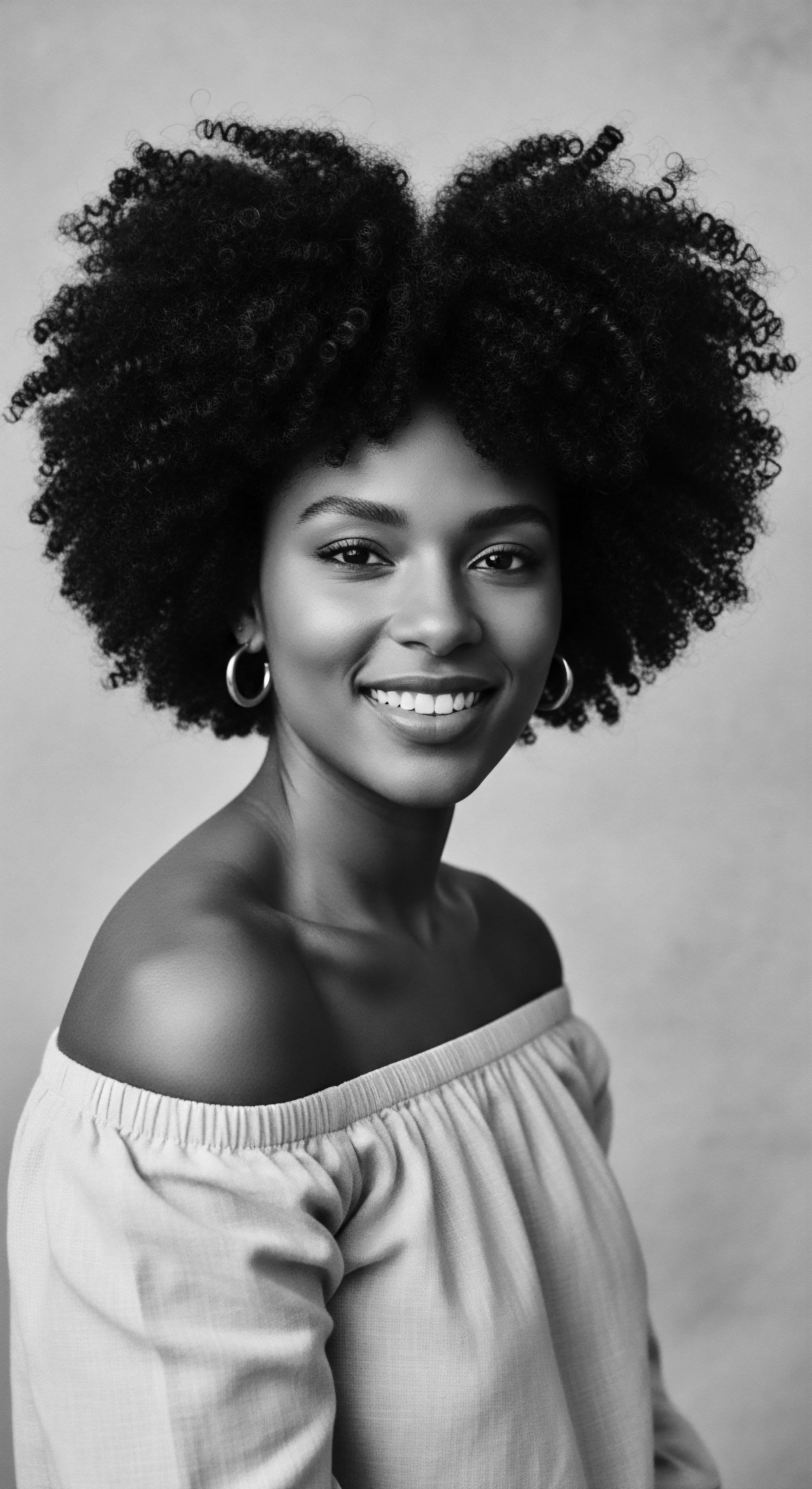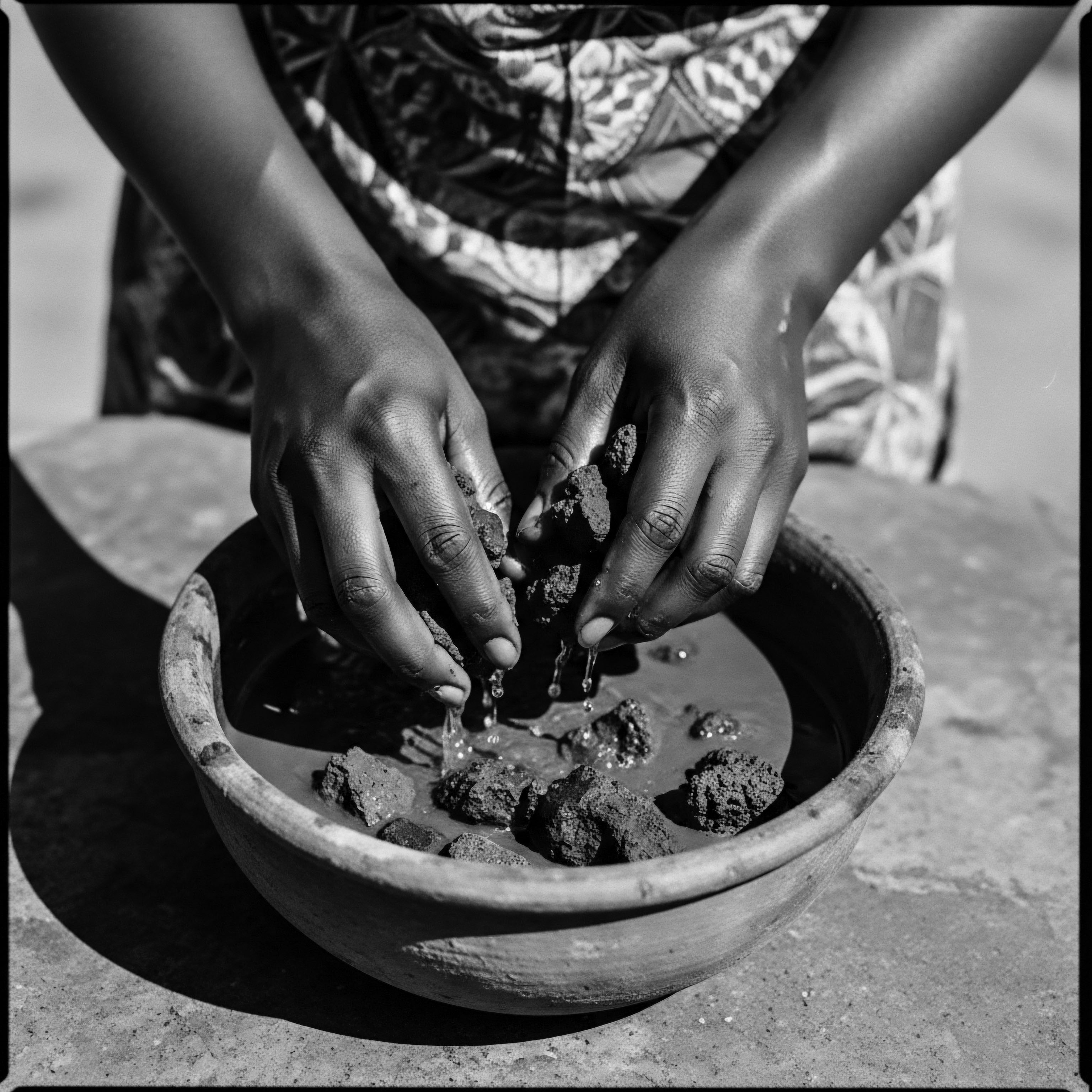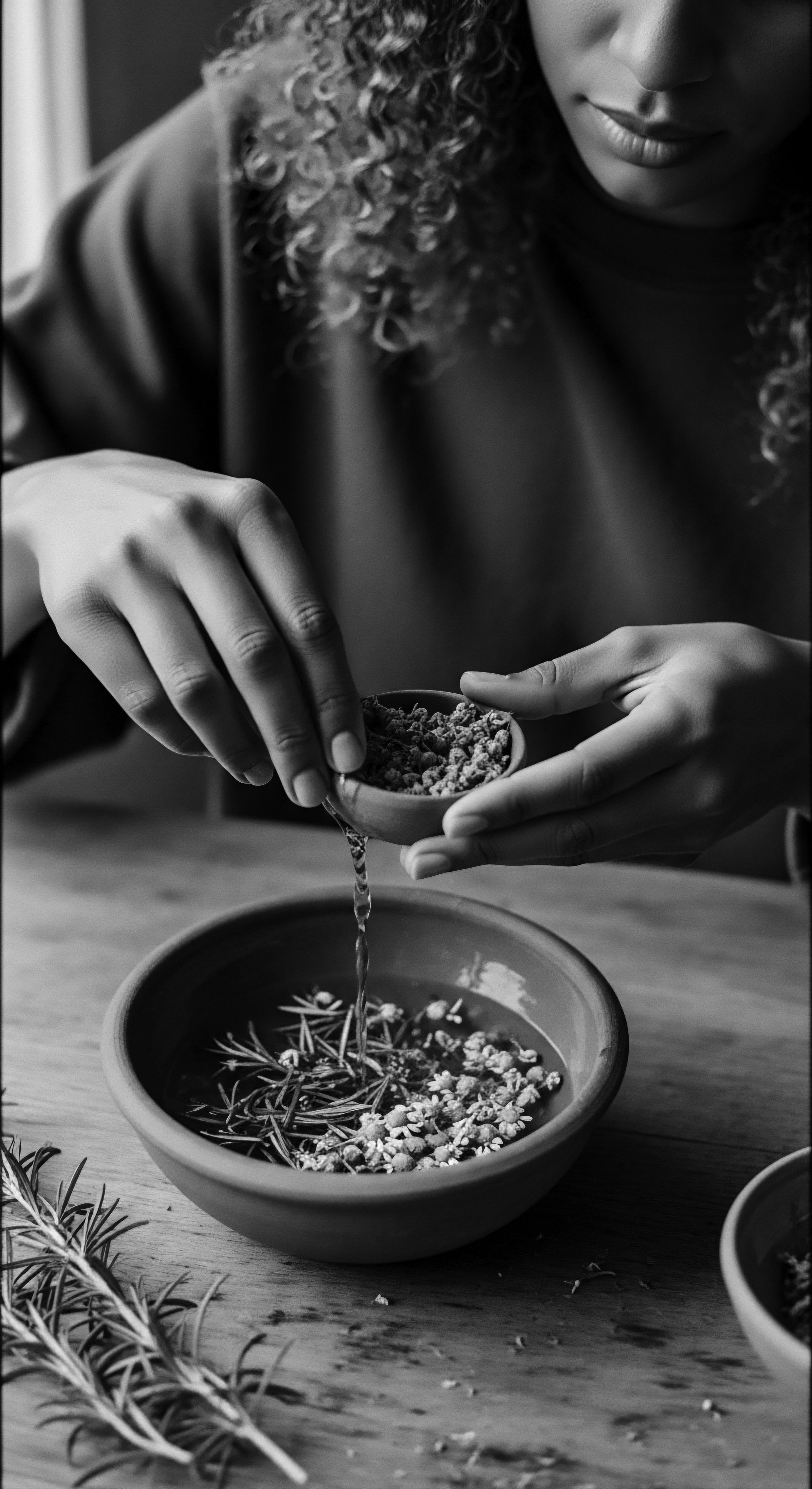
Fundamentals
The concept of Hormonal Balance, when considered through the lens of textured hair heritage, extends beyond a mere biological equilibrium within the body. It signifies a profound state of internal harmony, where the intricate dance of hormones—those potent chemical messengers—supports the flourishing of one’s entire being, including the vitality and resilience of textured hair. This fundamental understanding is not solely a modern scientific revelation; rather, it echoes the ancient wisdom that recognized the interconnectedness of bodily systems long before contemporary laboratories could quantify hormone levels.
At its simplest, Hormonal Balance describes the optimal functioning of the endocrine system, a network of glands producing hormones that regulate nearly every bodily process. These processes range from metabolism and growth to mood, reproduction, and, significantly for our exploration, hair growth cycles and scalp health. When these hormones are in their proper proportions and rhythm, the body maintains a state of ease, allowing for robust hair growth, healthy skin, and a general sense of well-being. A deviation, however subtle, can manifest in various ways, often impacting the hair first, as it is a sensitive barometer of internal shifts.
For communities with textured hair, particularly those of Black and mixed-race descent, the meaning of Hormonal Balance is inextricably linked to generations of lived experience. It speaks to the historical and ongoing challenges faced in maintaining hair health amidst societal pressures and, at times, inadequate understanding of their unique hair needs. The search for balance, therefore, becomes a quiet act of self-preservation, a continuation of ancestral practices that sought to align the body with natural rhythms and environmental harmony. This foundational clarification grounds our deeper exploration.
Hormonal Balance, at its core, represents an internal equilibrium supporting the holistic well-being and vibrant expression of textured hair, echoing ancient wisdom and modern scientific understanding.

Understanding Hormones and Hair Cycles
The relationship between hormones and hair is a delicate ballet. Androgens, a group of hormones including testosterone, play a significant role in hair growth. While often associated with male characteristics, these hormones are present in everyone. In certain contexts, an excess of particular androgens can shorten the hair growth phase, leading to thinning or hair loss.
Conversely, hormones like estrogens can prolong the growth phase, contributing to fuller, longer hair. The thyroid hormones, produced by the thyroid gland, also influence hair follicle function and overall hair health. When thyroid levels are askew, hair can become brittle, dry, or experience excessive shedding.
The hair growth cycle itself has three main phases:
- Anagen ❉ The active growth phase, where hair follicles produce new hair strands.
- Catagen ❉ A transitional phase where hair growth stops and the follicle shrinks.
- Telogen ❉ The resting phase, after which old hair sheds and new hair begins to grow.
Hormonal shifts can disrupt this cycle, pushing more hair into the resting or shedding phases prematurely. This can be observed in situations like postpartum hair shedding, where a sudden drop in estrogen levels after pregnancy leads to a noticeable increase in hair fall. Understanding this basic biology provides a framework for appreciating how internal shifts can ripple outwards, affecting the very crown we wear.

Intermediate
Moving beyond the foundational definition, the intermediate understanding of Hormonal Balance for textured hair communities involves a deeper appreciation of its significance within a broader socio-historical and physiological context. This is not merely about identifying a chemical equilibrium, but about comprehending the profound influence of inherited experiences, environmental stressors, and cultural practices on this delicate internal state. The meaning here expands to encompass the resilience and vulnerability woven into the very strands of Black and mixed-race hair.
Consider the pervasive impact of stress, a silent disrupter of hormonal harmony. Chronic stress, whether from daily societal microaggressions or systemic discrimination, elevates cortisol levels. This stress hormone can interfere with other hormonal pathways, potentially impacting hair follicle health and leading to conditions like telogen effluvium, a temporary hair shedding often linked to significant stressors (Aguh, 2025).
For Black women, the burden of navigating Eurocentric beauty standards, coupled with the psychological toll of hair-based discrimination, adds a layer of complexity to their hormonal landscape (Maharaj, 2025). The constant pressure to conform, sometimes involving harsh chemical treatments or tight styling, can create a cycle of physical and psychological strain that directly influences hair health and, by extension, hormonal well-being (Maharaj, 2025).
For textured hair, Hormonal Balance transcends biology, becoming a reflection of enduring cultural resilience and the often-unseen toll of societal pressures on physiological well-being.

The Echoes of Ancestral Practices
Ancestral wisdom, often passed down through generations, implicitly understood the connection between internal balance and external vitality, including hair health. Traditional healing practices across African and diasporic communities frequently incorporated herbs and rituals aimed at restoring equilibrium, long before the term “hormonal balance” entered scientific discourse. These practices, while not explicitly labeling hormonal pathways, intuitively addressed the underlying physiological states that support robust hair growth.
For instance, the use of certain botanicals in traditional African medicine to support reproductive health or alleviate menstrual discomfort—conditions often linked to hormonal fluctuations—also likely contributed to overall well-being, which in turn would benefit hair. Tshikwane, a potent herb native to Southern Africa, has been used for centuries to address issues related to fertility, sexual function, and hormonal balance, often alleviating menstrual discomfort and regulating cycles (Seamoss Africa, 2024). While its direct impact on hair was perhaps not the primary focus, a body in greater balance is a body more capable of supporting vibrant hair.
| Traditional Practice/Ingredient Baobab Oil (African) |
| Potential Link to Hormonal Balance/Hair Health (Heritage Context) Used for centuries to nourish and protect hair, often associated with strength and vitality. Its use speaks to a holistic approach to scalp and strand health. |
| Modern Scientific Parallels/Understanding Rich in fatty acids and vitamins (A, D, E, F), which are essential for cell membrane integrity and can support overall physiological function, indirectly aiding hair health. |
| Traditional Practice/Ingredient Rooibos Tea (South African) |
| Potential Link to Hormonal Balance/Hair Health (Heritage Context) Consumed for general well-being and its calming properties, contributing to a sense of internal peace. |
| Modern Scientific Parallels/Understanding High in antioxidants, reducing oxidative stress which can negatively impact hair follicles. Contains zinc and copper, minerals vital for hair growth and preventing premature graying (AYANAE, 2024). |
| Traditional Practice/Ingredient Hibiscus (African/Asian Diaspora) |
| Potential Link to Hormonal Balance/Hair Health (Heritage Context) Used in traditional hair washes and masks for conditioning and promoting growth, revered for its beautifying properties. |
| Modern Scientific Parallels/Understanding Contains vitamins A and C, amino acids, and alpha-hydroxy acids, which strengthen roots, reduce thinning, and stimulate dormant follicles (AYANAE, 2024). May help balance scalp pH, reducing issues like dandruff (AYANAE, 2024). |
| Traditional Practice/Ingredient Neem and Shikakai (Ayurvedic/Indian, but widely used in diasporic contexts) |
| Potential Link to Hormonal Balance/Hair Health (Heritage Context) Valued for cleansing and treating scalp conditions, aligning with ancestral practices of maintaining a healthy foundation for hair. |
| Modern Scientific Parallels/Understanding Neem possesses antifungal, antibacterial, and anti-inflammatory properties, treating scalp conditions that impede growth. Shikakai is a gentle cleanser, supporting scalp health (AYANAE, 2024). |
| Traditional Practice/Ingredient Stress-Reducing Rituals (e.g. communal hair braiding) |
| Potential Link to Hormonal Balance/Hair Health (Heritage Context) Provided emotional support, reduced anxiety, and fostered community bonds, creating a calming environment. |
| Modern Scientific Parallels/Understanding Lowering cortisol levels through relaxation and social connection can positively impact the hair growth cycle and reduce stress-related hair shedding (Aguh, 2025). |
| Traditional Practice/Ingredient These examples underscore the deep, often unarticulated, wisdom within ancestral hair care practices that inherently supported the body's natural balance. |
The understanding of Hormonal Balance at this intermediate level therefore recognizes that it is not merely a biological state, but a dynamic interplay between internal physiology, external pressures, and the enduring legacy of cultural wisdom. The implications for textured hair are profound, highlighting the need for care approaches that acknowledge this complex web of influences.

Academic
The academic delineation of Hormonal Balance, particularly when examined through the lens of textured hair heritage, necessitates a rigorous, multi-disciplinary exploration. It moves beyond simplistic cause-and-effect relationships, embracing the intricate, often reciprocal, connections between endocrinology, genetics, psychology, and the deeply rooted cultural experiences of Black and mixed-race individuals. This interpretation recognizes Hormonal Balance not as a static condition, but as a fluid, responsive state shaped by both intrinsic biological predispositions and extrinsic environmental, social, and historical forces. The meaning here is a complex tapestry, revealing how centuries of adaptation and resilience have molded the very physiological expressions of textured hair.
From a precise academic perspective, Hormonal Balance refers to the homeostatic regulation of endogenous hormones, ensuring their concentrations and receptor sensitivities maintain physiological functions within optimal parameters. Deviations, or dysregulation, can lead to cascades of effects. For hair, the androgenic hormones, specifically dihydrotestosterone (DHT), play a critical role in androgenetic alopecia, a common form of hair loss.
In genetically predisposed individuals, heightened sensitivity of hair follicles to DHT can lead to miniaturization of the follicle, shortening the anagen phase and eventually leading to thinner, finer hair or complete cessation of growth. While this mechanism is well-documented across populations, its manifestation and impact within textured hair communities acquire additional layers of complexity due to unique hair characteristics and historical contexts.
Consider the compelling evidence linking chronic stress to hair loss in Black women. Research indicates that for Black women, anxiety is often more chronic and its symptoms more intense compared to their white counterparts (Neal-Barnett, 2021). This heightened stress response, stemming from systemic racism, microaggressions, and the pressure to conform to Eurocentric beauty standards, can significantly disrupt hormonal equilibrium.
Elevated cortisol, a key stress hormone, can interfere with the hypothalamic-pituitary-adrenal (HPA) axis, influencing the production and regulation of other hormones crucial for hair growth. This prolonged stress can precipitate conditions like telogen effluvium, where a large number of hairs prematurely enter the resting phase, leading to widespread shedding (Aguh, 2025).
A particularly salient example of this interplay is the prevalence of certain forms of alopecia within the Black community. While genetic predispositions play a role, environmental factors, including chronic stress, are linked to the cause and progression of conditions such as Alopecia Areata (AA) (McElwee et al. 2013; Islam et al. 2015; Pratt et al.
2017 cited in Barkauskaite & Serapinas, 2020). Furthermore, Central Centrifugal Cicatricial Alopecia (CCCA), a form of scarring hair loss, is notably prevalent in Black women, often exacerbated by chemical treatments and tight styling practices (Aguh, 2025; Belgravia Centre, 2016). The psychological distress associated with hair loss, which for Black women is often deeply intertwined with identity and cultural continuity, can create a feedback loop, intensifying stress and potentially worsening hormonal dysregulation (Maharaj, 2025; Barkauskaite & Serapinas, 2020). As one participant in a TRIYBE lab workshop articulated, “When I lost my hair, I didn’t just lose strands … I lost a part of my identity” (Maharaj, 2025). This profound sense of loss underscores the non-cosmetic nature of hair health in these communities and its deep connection to mental and emotional well-being, which are intrinsically linked to hormonal balance.
The academic understanding of Hormonal Balance for textured hair unveils a dynamic interplay between biological processes, inherited resilience, and the pervasive impact of socio-historical stressors.

Interconnected Incidences ❉ Hair, Identity, and Systemic Pressures
The psychological literature offers a compelling perspective on the intersection of hair, identity, and mental health within the Black community, which directly impacts discussions of hormonal well-being. The devaluation of Black hair, often internalized due to societal standards that prioritize Eurocentric aesthetics, is psychologically damaging (Cokley, 2023). This internalized racism can contribute to chronic stress and anxiety, creating an environment ripe for hormonal disruption (Maharaj, 2025).
For example, studies show that Black women frequently feel pressure to chemically straighten their hair to avoid discrimination in professional and academic settings, a practice that can be both physically damaging to hair and psychologically taxing (Maharaj, 2025). This continuous tension, a consequence of systemic bias, places an extraordinary burden on the physiological systems that maintain hormonal equilibrium.
The very act of hair care, which for many is a ritual of self-affirmation and connection to ancestry, can become a source of stress when societal norms dictate what is “acceptable.” The historical context of hair wraps used by enslaved Black women to appear less attractive to their owners, or the ongoing battles against hair discrimination in schools and workplaces, illustrate how deeply ingrained these pressures are (Ancestral Memory Therapy, 2023; Bounce Black, 2024). These experiences are not merely anecdotal; they represent chronic stressors that can contribute to sustained physiological responses, influencing hormonal pathways.
- Stress and Hair Loss ❉ Research from Dr. Angela Neal-Barnett indicates that Black women experience anxiety more chronically and intensely than their white counterparts, contributing to hair loss (Neal-Barnett, 2021).
- Alopecia and Identity ❉ For Black women, hair loss, such as alopecia, can profoundly impact self-esteem and identity, highlighting hair’s cultural significance as “the crown” (Barkauskaite & Serapinas, 2020; Aguh, 2025).
- Hair Discrimination ❉ Persistent societal and institutional discrimination against natural Black hairstyles creates ongoing stress, influencing mental health and potentially exacerbating hair issues (Maharaj, 2025; Cokley, 2023).
The exploration of Hormonal Balance at this academic level reveals that it is not a standalone biological phenomenon. Instead, it is deeply interwoven with the psychosocial realities and historical legacies of textured hair communities. Understanding its full scope requires a nuanced appreciation of how ancestral resilience, systemic pressures, and the profound cultural significance of hair coalesce to shape an individual’s internal hormonal landscape. This holistic approach offers a richer, more accurate interpretation of the term, moving beyond reductionist views to honor the complex lived experiences that inform hair health.

Reflection on the Heritage of Hormonal Balance
As we close this contemplation on Hormonal Balance, the echoes from the source reverberate, reminding us that its meaning for textured hair communities is a living, breathing testament to enduring heritage. This is not a concept confined to sterile laboratories or modern medical texts alone; it is a wisdom carried in the collective memory of generations, whispered in the tender thread of hair care rituals, and voiced in the unbound helix of identity. The notion of balance, whether spoken in ancient tongues or understood through contemporary science, has always been an inherent part of nurturing the crown.
From the communal spaces where hands worked together to braid and adorn, creating styles that signified status, tribe, and spiritual connection, there was an intuitive recognition of holistic well-being. These practices, steeped in reverence for the body and its natural rhythms, implicitly contributed to a state of internal harmony. The traditional remedies, passed down through matriarchs and healers, often aimed at restoring systemic equilibrium, which in turn fostered vibrant hair growth and overall vitality. The strength of a strand was seen as a reflection of the strength of the spirit, and the health of the scalp mirrored the health of the community.
Even in the face of immense historical challenges—from the brutal disruptions of enslavement that severed connections to ancestral practices, to the ongoing pressures of assimilation and discrimination—the pursuit of balance persisted. The ingenuity of those who found ways to maintain hair health despite adversity speaks volumes about the deep-seated understanding that hair is more than fiber; it is a profound marker of self, a connection to lineage, and a symbol of resistance. The psychological toll of hair discrimination, as highlighted by research, is a modern manifestation of historical burdens, underscoring how external pressures can ripple inward, affecting the very hormonal systems that govern our well-being.
Today, as textured hair finds its voice in a world increasingly recognizing its inherent beauty and cultural richness, the dialogue around Hormonal Balance takes on renewed significance. It is a call to honor the ancestral knowledge that understood the body as an integrated whole, where the health of one part influences all others. It invites us to consider how our choices—from the ingredients we use, to the ways we manage stress, to the narratives we internalize about our hair—can either disrupt or restore this delicate equilibrium. The journey towards hormonal balance for textured hair is thus a continuation of a sacred heritage, a commitment to self-care that is both deeply personal and profoundly communal, securing the future of the unbound helix for generations to come.

References
- Aguh, C. U. (2025, March 26). Dermatologists Advocating for Inclusive Hair Loss Research and Treatment in the African Diaspora. American Journal of Managed Care .
- Barkauskaite, L. & Serapinas, D. (2020). Hair is your crown and glory – Black women’s experiences of living with alopecia and the role of social support. BMC Psychology, 7(1), 1-7.
- Cokley, K. (2023, December 12). The Politics of Black Hair. Psychology Today .
- Maharaj, C. (2025, May 15). Beyond the roots ❉ exploring the link between black hair and mental health. TRIYBE Research and Community Dialogues.
- McElwee, K. J. et al. (2013). Stress and the hair follicle. Experimental Dermatology, 22(1), 3-10.
- Neal-Barnett, A. (2021, February 17). Stress Induced Hair Loss? Black Women Are Among the Most Vulnerable. Modern Salon .
- Seamoss Africa. (2024, August 21). Tshikwane ❉ The Herb That Boosts Reproductive Health and Vitality.
- The Belgravia Centre. (2016). Study ❉ Almost Half of African American Women Affected by Hair Loss.
- Ancestral Memory Therapy. (2023). Black Hair Depression ❉ Our Perspectives On Black Hair.
- AYANAE. (2024, August 29). Powerful African and Asian Herbs for Hair Growth ❉ Nature’s Remedies.
- Bounce Black. (2024). Hair and Mental Health.
